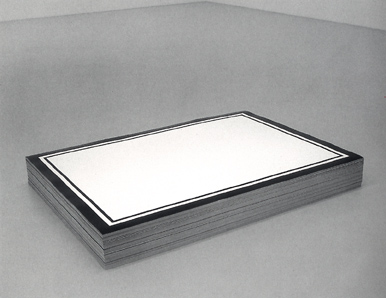
Untitled (Republican Years), Felix Gonzalez-Torres, 1992
currently in “Stacked” at D’Amelio Terras
If you are boycotting the French right now, you’re a loser. They’re putting on some of the best shows in town. Additions to an incomplete list:
On A Big Art Thursday
Last night at a friend’s house, Jeremy Blake showed us some recent work and talked about it.
The New Museum previewed a strong group show, “Living Inside the Grid,” where Dan Cameron exercises his international muscles in advance of the Istanbul Biennial. There are some obvious (and thus, intentional) omissions, but many nice pieces, including a creepy-sleek prison door by Elmgreen & Dragset.
And finally, while I didn’t make the opening, the after-party came to us at dinner: The Whitney opens a show about Diller + Scofidio, architects who have PR-muscled their way to the front of the technology/media stage. Eager to make amends for the dustup caused by his baldly partisan, king-making articles about the WTC redesign, the NYTimes‘ Herbert Muschamp returns to clear-eyed, of-the-people objectivity in his review. Here’s the first paragraph:
The search for intelligent life in architecture is artfully rewarded at the Whitney Museum’s retrospective of the work of Elizabeth Diller and Ricardo Scofidio, New York’s brainiest architectural team. But intelligent visitors will have to pick their way through a few unwelcome booby traps: curatorial winks and nods designed to dumb things down for the chimerical unsophisticates to whom far too many museum shows today are needlessly pitched.
Architectural Survivor 3: See Who Gets Voted Off The Island
It’s architectural reality TV, with so many last-minute campaigns, twists and turns, you’d think Fox was running it, not the Port Authority. The final two bachelors, er architect groups in the design “competition” for the WTC site have been workin’ it hard, according to design reporter Julie Iovine’s NYTimes article, even turning up on Oprah. Herbert Muschamp weighs in, too, slightly chastened. Meanwhile, Edward Wyatt’s report of a LMDC committee’s surprise recommendation of THINK over (the Pataki/Bloomberg-favored) Libeskind sounds like a promo for the finale of Joe Millionaire. And just as “surprising,” or “real,” for that matter. Whether angling to arrive at a lecture with a victim family member or throwing shade on each other’s designs, these architects ingenuously perform for the camera.
Night Of A Thousand Film Geeks
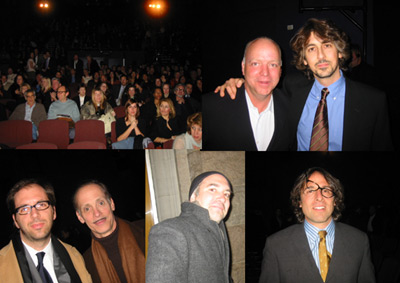
clockwise from top R: UA’s Bingham Ray and honoree Alexander Payne
David O. Russell, last year’s honoree, still in a euphoric daze
“special friend”/screenwriter Jim Taylor, freezing on way to afterparty
John Waters and sycophantic fan, photo: David Russell
crowd shot, which captured the supposedly elusive cracked-me-up international man of mystery
Last night at MoMA, Alexander Payne and Bingham Ray talked about Payne’s career and films (including Citizen Ruth, Election, About Schmidt). The Museum’s Film & Media Department gave Payne its Work In Progress Award, to honor filmmakers as they transition from “promising” to “proven.” Ray, who’s an independent film legend himself, and who heads United Artists (which picked up Pieces of April at Sundance), studio headed the conversation.
In my secret socialite life, I co-chaired the benefit. I’m working up my notes from Alexander’s discussion (and will try to score some audio clips, too) and will post a page of pictures soon. In the mean time, here is a composite pic, and the highlights of my speech:
More On Punch-Drunk Love and Jeremy Blake
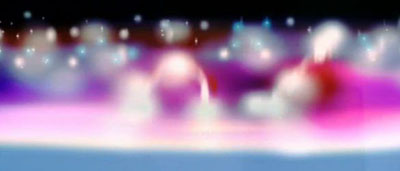
Been making arrangements for a private preview of a new work by Jeremy Blake, who I’ve been friendly with for many years, since his first NY show. While putting together an email of links and background for people, I went back to the official site for Paul Anderson’s film, Punch-Drunk Love [DVD, someday]. Under “movies”, there is a collection of 14 haiku-like clips, which use liberal doses of Jeremy’s abstracted work and Jon Brion’s film music, often without any dialogue, or even ambient sound. They’re really great, like a bowl of film candy.
A search of the web for any discussion of them turned up nothing, but ptanderson.com, the blow-away best “unofficial” filmmaker fansite around, comes to the rescue, sort of. In addition to a section on Jeremy and his work (including a what/where inventory of his work in PDL), there’s a list of deleted scenes which maps pretty closely onto the website movies. PDL is the most overlooked movie of the award season. And not just acting/directing/writing, but the whole gamut of editing, production design, sound, lighting, music, I mean, come on.
Now We’re Gettin’ Somewhere, Gerry
The compelling/amusing Super Mario Brothers: A Literary Criticism (thanks, Jason!), which puts paid to my (non-)critique of the connections between Gerry, its filmic antecedents, and SimCity-style video games.
First, Let Me Say, Daniel, We Loved Your Idea
 And (according to the Guardian), we’d really like to move forward with it. We made just a couple of notes, ‘Kay?
And (according to the Guardian), we’d really like to move forward with it. We made just a couple of notes, ‘Kay?
On Museums On eBay
This AP story [via the cool Scrubbles.net] from Indianapolis sounds like the tip of the iceberg: museum curators using ebay to add to their collections.
My conversations about eBay with various curator friends all follow a predictable a trajectory: surprise that we’re both eBay whores; polite envy over what the other scored; caginess over what we’re looking for now; relief when we find out we’re looking for different stuff; quick detente and an exchange of usernames when we find out we’re buying the same stuff.
Of course, now eBay’s gonna turn my butt in to the Feds, as the EFF reports they’re all too eager to do.
On Wooster Collective
As I arrived at Gawker’s launch party last week, I ran into some friends from my old consulting days. (I guess it’s Nick’s job to know everybody, and he does.) Anyway, their shoutout just before the elevator door closed, “we have a weblog, Wooster Collective” should be nominated for Undersell Of The Year.
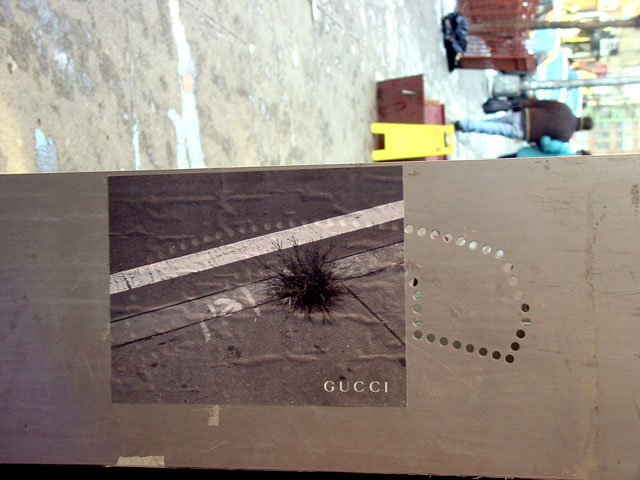
Wooster Collective is a hoppin’ arena of grafitti, stickers, stencil art and other street art, with updates coming more frequently than the 4-5-6 train at rush hour. In a remarkably short time, they’ve tapped into a sprawling network of artists and fans who contribute great stuff from far beyond Wooster.
Some highlights: Posters of sidewalks by Gucci, et al; Peter Coffin’s barcode stickers [Peter, you gotta tell me about this stuff…]; and Dan Witz interview, whose trompe l’oeil graf works are stunning.
As If greg.org Needed Another Matthew Barney Reference…

Yeah, I want a Cremaster belt buckle, but not if it means
getting executed in a salt arena… image: guggenheim.org
‘cuz it’s gonna be all we talk and hear about for months (at least until Matrix Reloaded comes out). We’re just suckers for an entirely fabricated, all-encompassing, and disturbing worldview. (What, the imagined world of Wolfowitz ain’t scary enough?)
Anyway, in the Times, Michael Kimmelman gets all sticky for the Cremaster show, which opens today at the Guggenheim. Note to all: Fridays through June 6, are hereby set aside for watching the entire 5-film Cycle, in order. You will be graded on this.
Note to MB: If Prada teaches the world anything, it’s to actually have a site up when you go wide with a marquee URL.
Shipping Containers, v. 3
A sporadically recurring topic here at greg.org, the non-shipping use of shipping containers. [Instigating post here, extensive post here.]

Shipping container used in an illegal Israeli outpost, image:nytimes.com
Samantha Shapiro’s NYTimes Mag story, “The Unsettlers,” profiles young, militant Israelis who pioneer illegal settlements in the West Bank.

Shipping container used in an illegal Israeli outpost in the Jordan Valley, image:metropolismag.com
Stephen Zacks’ review in the Feb. 2003 Metropolis of a (cancelled) exhibit on architecture and urban planning in the West Bank, where Israeli hilltop settlements use suburban sprawl to control the surrounding territory. Architect Eyal Weizman: “It’s almost like you have a model of the terrain and you cut a section at say six hundred meters, and everything that’s above is Israeli. What was created was an incredible fragmentation of the terrain into two systems that work across the vertical axis.” The Israeli human rights group B’Tselem has published Weizman’s exhaustively documented settlement map of the West Bank.
For all your settling needs, illegal or otherwise, the Shipping Container Store: passing the mountainous container landscape along the NJ Turnpike, I saw Interport Maintenance Corp., which sells shipping containers. Delivery is extra.
If Ric Burns Calls, Tell Him You’re Busy.
Today’s Guardian asks twelve actual historians to lend their authoritative-sounding accents on politicians’ arguments that Iraq is the next [check all that apply]
1939 Germany
1956 Egypt
1967 Israel
1991 Iraq
1963 Vietnam
1899 South Africa
1936 Ethiopia
A long time ago in a galaxy far, far away Naboo
As someone who made a movie (S(N01)) about looking at the past (WWI) to make sense of the present (Sept. 11), I’m interested. One big lesson is best expressed by Simon Schama: “I’m allergic to lazy historical analogies. History never repeats itself, ever. That’s its murderous charm.”
Another: historians are almost as likely as politicians to slip from historical analogy to histrionic advocacy. For example Andrew Roberts‘ unsubtle derision: “The League of Nations, on the morning after Poland was invaded, had on its urgent agenda the standardisation of European railway gauges. Today’s United Nations is fast shaping up to be equally ineffectual.” (See if you can read between ‘ lines.)
And even though it would catapult S(N01) up the relevance scale, I hope Norman Davies is wrong comparing Iraq to 1914 Russia:
So what about 1914? The strongest military power in sight (Germany) is made to feel insecure by a terrorist outrage. Instead of confining its response to the known source of the terrorism (Serbia), it lashed out at one country, which it suspected of abetting the terrorists (Russia), and then at another country (France), which was linked to the first. Then it lost the plot. Worst of all, it calculated that the war would be won by Christmas.
On Thomas Struth On Art
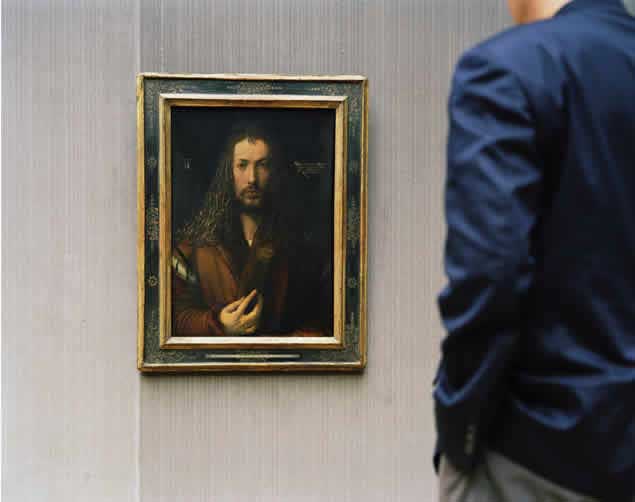
Alte Pinakothek, Selftportrait, Munich, 2000, Thomas Struth
The other night, I heard the photographer Thomas Struth talk about his work. A friend (who has a far more serious art habit than even I do) hosted a reception for the artist in his office. Extra Struths, brought out of storage for the evening, rested on stacks of printer paper, an installation technique you don’t see at the artist’s current one-man show at the Met.
Struth spoke very quietly, but determinedly, about his work and the ideas and process behind it. He’s clearly contemplative, and some of his most well-known works are unabashedly about contemplation (his Paradise junglescapes and his photos of museumgoers). He described his decades-long relationship with the 1500 self-portrait of Albrecht Durer (above) and his fascination with its unusual gaze. By putting himself in the photo (that’s Struth’s shoulder), he wanted to capture a moment of a conversation, while readily allowing that the two figures may not be saying anything to each other.
He caught me off guard, though, by referring to the photo’s cinematic character; but sure enough, the framing, blocking and “sightlines” are from one half of a shot/reverse-shot, the continuity editing staple for depicting a two-person conversation. Struth wanted to portray a conversation that crosses 500 years (he shot it in 2000), a long-term perspective Struth finds shamefully absent today.
“No one [in the current political situation] looks forward even 50 years; they only look to their next election.” Struth then ruminated on art worlders and what they could do to pull the real world back from the brink of war. “We’re here, in the office of [one of the wealthiest men in the world], there are so many influential people in the art world. Why don’t people use this powerful social network” to avert this global disaster?
Nervous silence, nervous chatter, and then a spurt of panged/defensive hands, as a few people tried to explain how our “standing here sipping champagne” was actually alright. An older guy with a Palm Beach tan leaned over and murmured to me, “I think we’re going in the wrong direction.” “That’s exactly what he’s talking about,” I deadpanned, “Oh, you mean the conversation.” Soon, we returned, quickly, safely, and completely, to discussions of how, exactly, he was able to get that amazing shot of the Parthenon. (“Because I’ve tried to shoot it every time I go, and it’s just so dark!”)
One implication in Struth’s photo, which cannot be avoided, of course, is our own responsibility. Shot/reverse-shot technique uses two components to establish the shared space; a reverse shot is needed. It would be a shot of Struth (and all of us, in the present day, standing in museums and galleries and private collections) from the perspective of Durer’s painted space, maybe over the 16th-century artist’s shoulder, a shot looking far into the future.
When Do You Cry Reading The Home Section?

Hardly ever, frankly. But William Hamilton’s wonderful story of the Kellams, a couple who lived alone, together, on an island off Mount Desert Island, really got me for some reason. Hamilton mentions David Graham’s book about the couple, Alone Together, published by Ponds Press
“What did he read to you,” Mrs. Kellam was asked…
“It was always the right thing,” she answered…
Kippy Stroud, a summer resident who runs an arts camp on Mount Desert Island, said, “We just admired them so much.” Ms. Stroud introduced Mr. Graham, William Wegman and other artists to Placentia to see the Kellams’ world as it faded, like a patch of light in a forest.
The story has the best ending I’ve ever read.
The Oscars: A Musical Comedy
About the Oscar nominations: Chicago is to movies what painted cows are to art.
